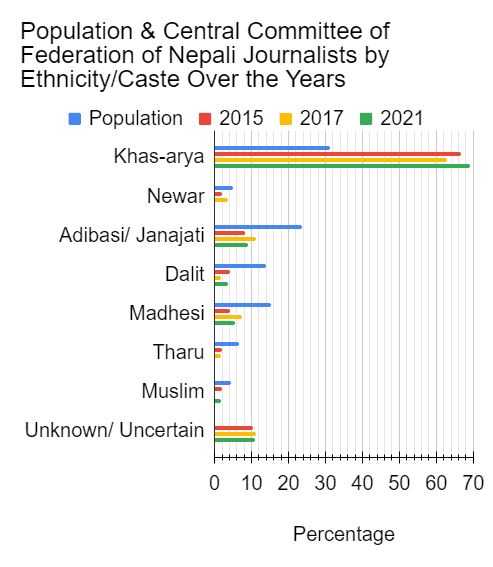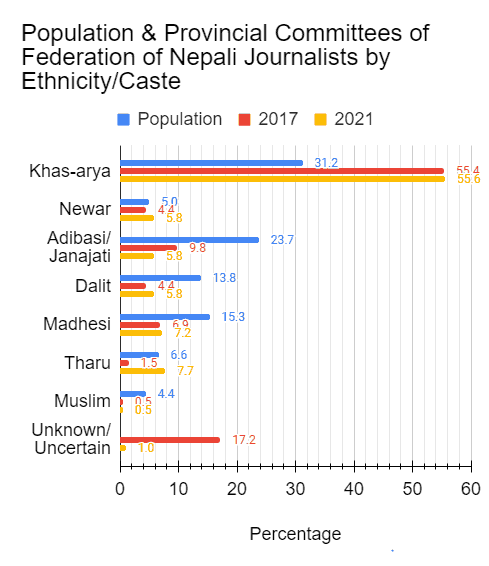You don’t have to be a sociologist or some professor involved in years of longitudinal study to know that Nepali media is atrocious.
They are highly insensitive and biased when it come to covering gender issues, ethnicity/caste issues, and religious issues other than that of Hinduism and potentially Buddhism. It is also highly misogynistic, among other things.
Nepal media is also not the fourth pillar of democracy (the other three being the Legislature, the Executive, and the Judiciary) it could have been, especially following the 1990 revolution when laws changed, media gained freedom and independence, and expanded. No different from many other systems in the country, it consistently supports, furthers, and thereby entrenches and props up the highly patriarchal and Brahmanical social, political, and economic power structures in the country.
I am sure there are many reasons behind that! For a long time, I also suspected that one reason must be who all is behind it.
Back in March, I voiced, in a twitter thread, questions I had had for a long time about that. If you happen to follow the link, you’ll notice that the thread starts with the second tweet. That’s because I accidentally deleted the first one. But here’s a reproduction of it.
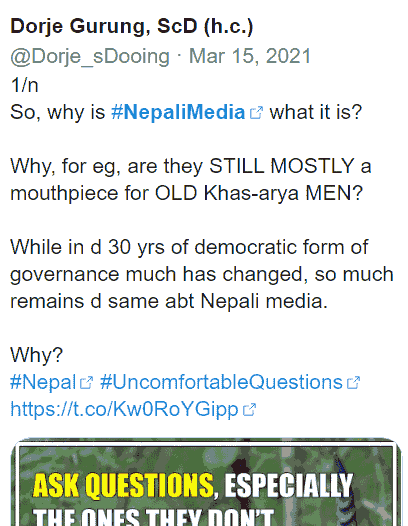
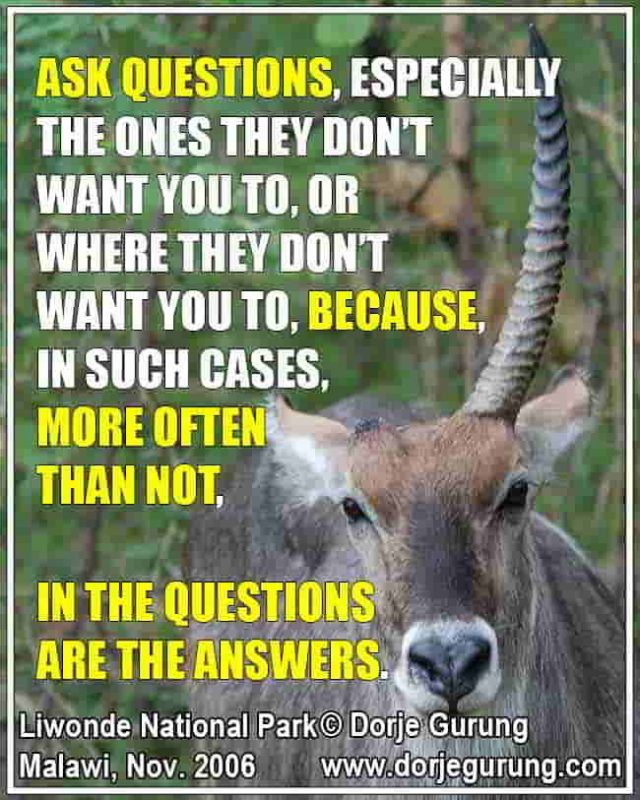
Sadly, many in Nepal don’t ask questions. One of the many reasons is that our education system does NOT teach students questioning skills and, worse, questioning is discouraged!
One of the questions I posed in the thread was, “Why haven’t/don’t they?” and also a theory about that, namely, “#NepaliMedia, like d #social, #political, & #economic #structures in #Nepal, are of, by, & for OLD Khas-arya MEN. I.e. it is just an #appendage of the same #beast!”
4/n
— Dorje Gurung, ScD (h.c.) (@Dorje_sDooing) March 15, 2021
Why haven’t/don’t they? My theory?#NepaliMedia, like d #social, #political,
& #economic #structures in #Nepal, are
of, by, & for OLD Khas-arya MEN.
I.e. it is just an #appendage of the same #beast!
What appendage or organ fights the body it’s a part of?! pic.twitter.com/iqgBNwfJdq
In the last two tweets in the thread, I asked why they have NOT done a “reckoning of themselves” and postulated why they won’t.
7/7
— Dorje Gurung, ScD (h.c.) (@Dorje_sDooing) March 15, 2021
And why hasn’t #NepalMedia done
so or why wouldn’t they do that?
Ofc, b/c they know what they’ll find,
& they themselves are NOT comfortable
with that truth.
In plain language, they haven’t &
won’t out of self-interest & tribal
(#caste) interest. #Nepal pic.twitter.com/UjJleq7LA7
Then on May 23, 2020, there was a heinous crime — a mob of 50-60 villagers hounded and murdered six Dalit males in Rukum, and disposed their bodies into the river with some of their arms tied behind their backs! Nepali media failed again and that forced me to revisit those questions. (I shall dwell on that incident and Nepali media in follow-up blog posts.)
Is Nepali media indeed of, for, and by Khas-aryas (the hill so-called high caste hindu) men? The answer is “yes” and I have the data.
Not long ago, I discovered the Federation of Nepalese Journalists’ (FNJ) homepage had considerably more information about their executives etc. since 2015 when I had first analyzed their Central Committee members. Since I was convinced that they wouldn’t be conducting a reckoning of themselves, I analyzed almost all the personnel information available on their website, including those of the 2017 office bearers. Lo and behold, Khas-arya (the hill so-called high caste Hindu) men are disproportionately highly represented!
Two points to note. The source of the breakdown of the national and provincial population by groups is this infograph produced by Nepal in Data, an infograph no longer available on their website.
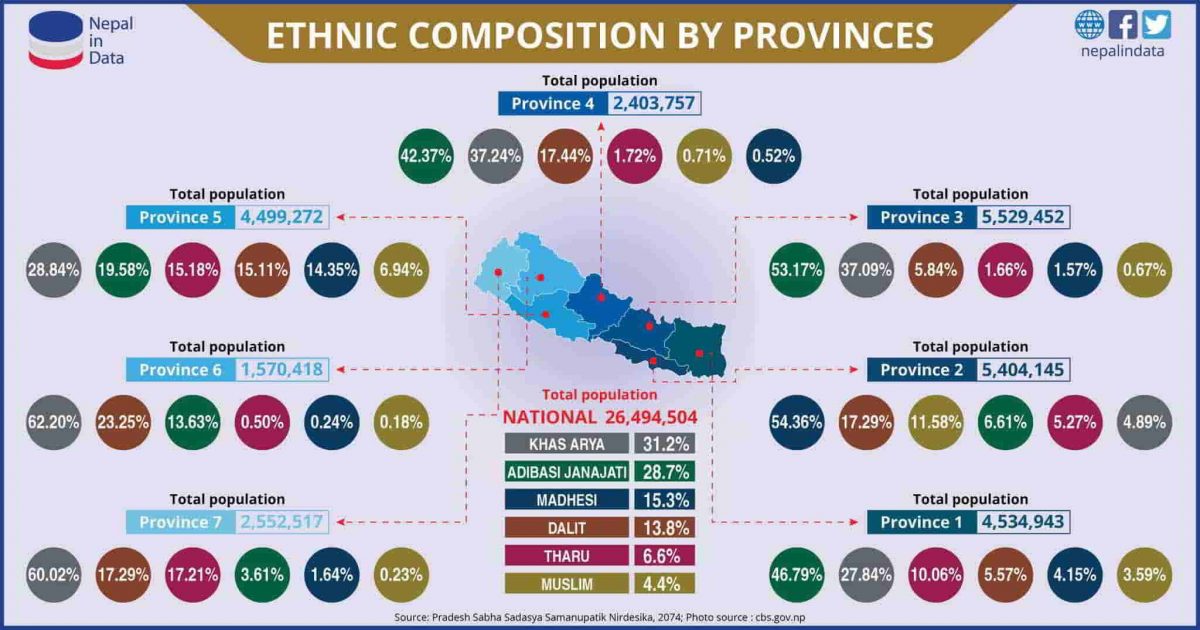
The second point is about the “Unknown/Uncertain” category. Surnames whose caste or category could not be determined using the sources I had were thrown into the “unknown” category. As for “Uncertain,” these were surnames common to two or more castes, such as सिंह (Singh) who could be a Newar, Khas-arya, or a Tharu; Joshi who could be a Khas-Arya or a Newar; चौधरी (Chaudary/Chaudari) who could be a Tharu or a Madhesi etc. On to the charts.
Here’s how the current Central Committee members and those of the last two years break down. The elections for the 2021 Committee were held not long ago.
Notice the Khas-aryas, while representing 31% of the population, made up 67% in 2015 and 63% in 2017 and now make up 69%, more than DOUBLE their proportion! No other group’s representation is even par with their own proportion in the population! Notice that even assuming the 10% Unknown/Uncertain members belonged to non-Khas-aryas does NOT significantly change their proportions.
FNJ has Povincial Committees. Here’s how all the members of the committees in 2017 and 2021 breakdown.
Here too, as you can see, disproportionately high percentage are Khas-aryas (55.4% in 2017 and 55.6% in 2021), though not as high as in the case of their Central Committee members. The other slight difference here from those of the Central Committee members is that in 2021, at 5.8% the Newars are represented slightly more than their proportion of 4.9% in the population.
Let’s have a look at the individual Provincial Committees. The discrepancy between the make-up of the population and the make-up of the Provincial Committees in a few cases is even more atrocious than in the Central Committee, which, I am NOT surprised by.
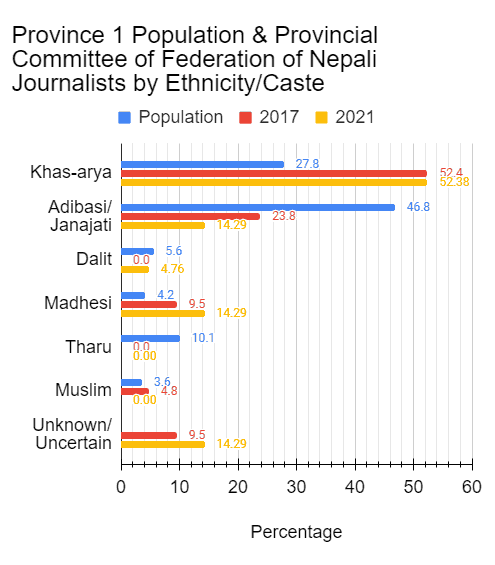
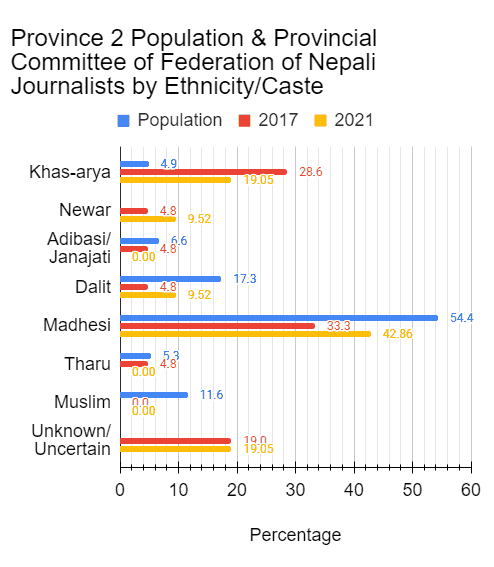
At 4.9%, Khas-aryas in Province 2 are the smallest social group. (Newars are an ethnicity and NOT a social group.) And yet, in 2017 their representation was almost 6-fold while now it’s almost 4-fold their proportion! Janajatis (at 6.6%) and Tharus (at 5.3%) had a lower representation in 2017, but in 2021 are NOT represented at all. The Dalits, proportionally more than 3-fold larger in population than Khas-aryas, are represented by a lower proportion.
The Muslims are the worst off. In spite of making up 11.6% of the population, more than twice that of the Khas-aryas, they were neither represented in 2017 nor are they represented in the current committee. The other kick in the face of the other groups here is the proportion of Newars. I wasn’t able to find the proportion of Newars in Province 2 but I suspect it’s a fraction of their representation in the committee of 4.8% and 9.52% in 2017 and 2021 respectively! After all, they only represent 4.9% of the entire population in the country and they are indigenous to Kathmandu Valley!
How is all that possible? Through gatekeeping, something the Khas-aryas have done throughout the entire modern history of the country!
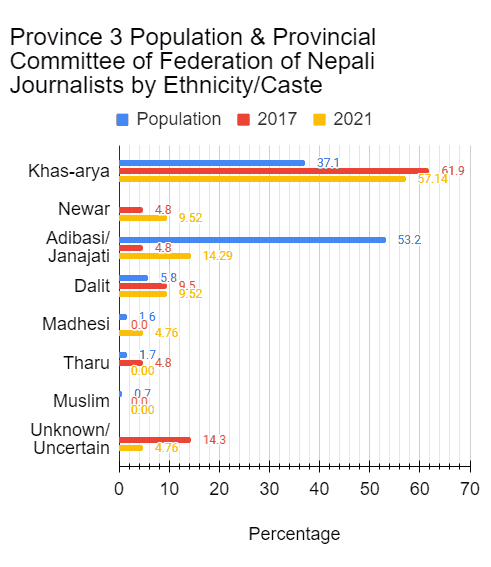
In Province 3, Dalits fare much better than in others. Who got shafted here the most? Janjatis, the majority in the province. Their representation in the committee is a fraction of the proportion of their population.
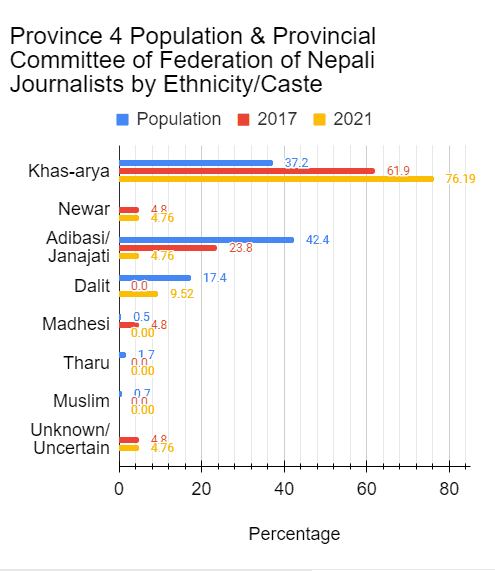
Province 4 is another one where the largest group are the Janjatis and in the current committee, their representation is less than 1/8th their proportion! Dalits in the current committee are doing better than in 2017 when they had NO representation. The other groups have NO representation.
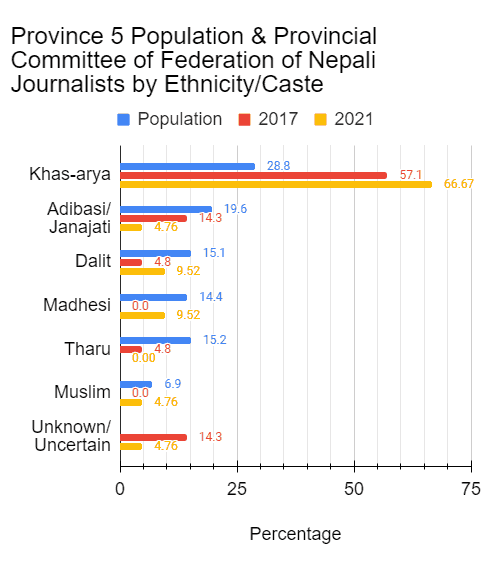
In Province 5, as in Province 4 as you can see, the Khas-aryas increased their representation in 2021 from 2017 from even the disproportionately high representation they had to begin with! The Tharus got totally shafted in 2021!
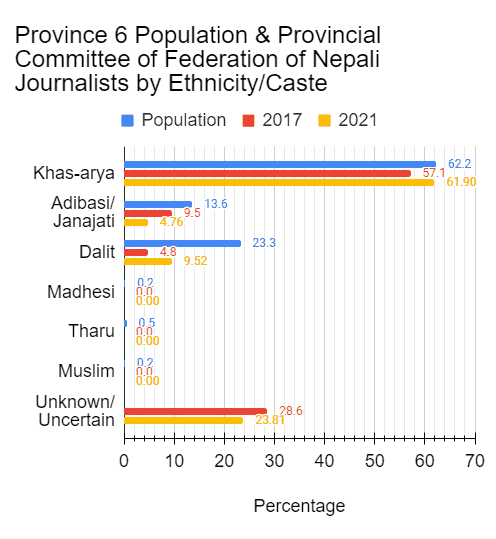
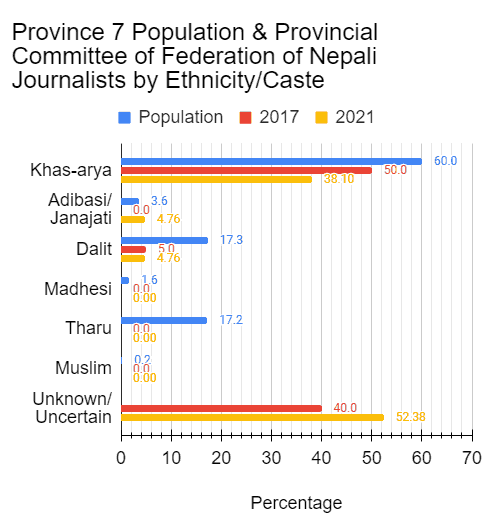
What can be said about the make-up of Province 6 and 7 that hasn’t already been said when discussing the other Provinces?!
A note about the very high percentage of unknown/uncertain members in both the cases of Karnali and Sudurpaschim. They consisted of surnames that I have never seen or heard AND my source didn’t list them. Given the very high percentage of Khas-aryas in both, I suspect a majority are Khas-arya but, again, I can’t be sure.
Next, let’s look at gender make-ups. Here’s a breakdown of the Central Committees by gender.
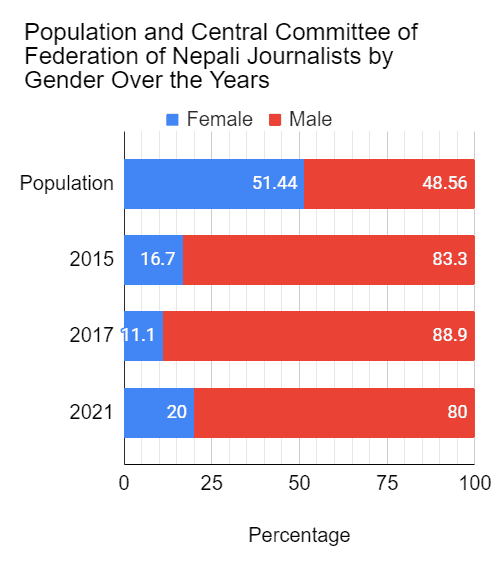
Males outnumber 4 to 1 in 2021 and it was worse in the other years!
The following chart breaks down the females by groups. Not surprisingly, disproportionately high percentage of them are…Khas-arya.
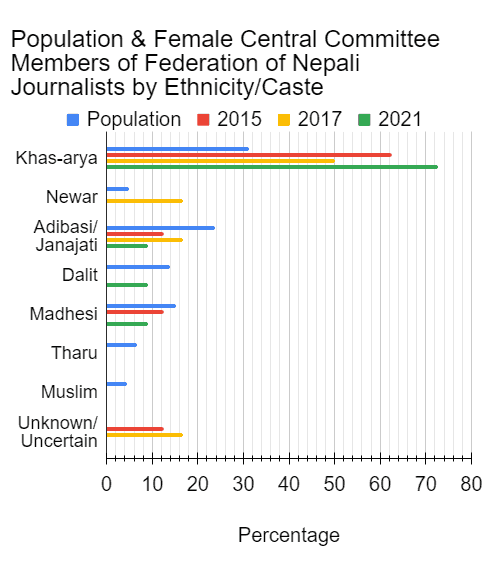
Breakdown of Provincial Committees by gender and the females members by groups, again, is really not much different.
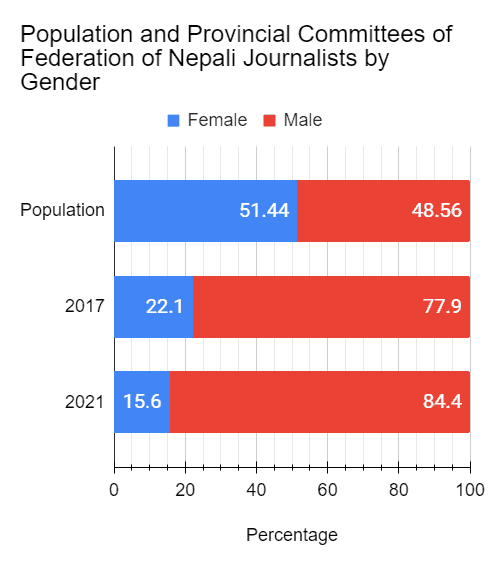
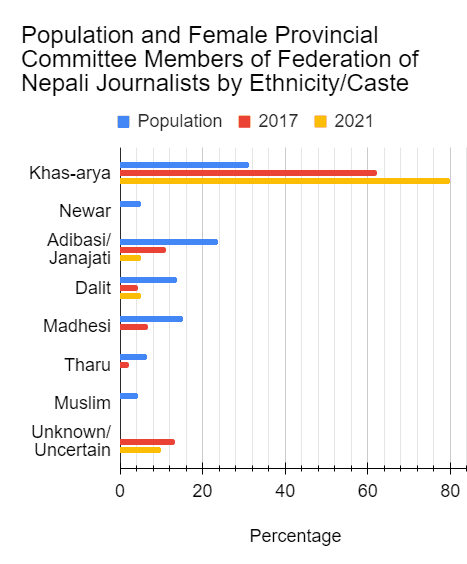
The FNJ website also lists the numbers of regular members in each province broken down by gender.
The histogram speaks for itself.
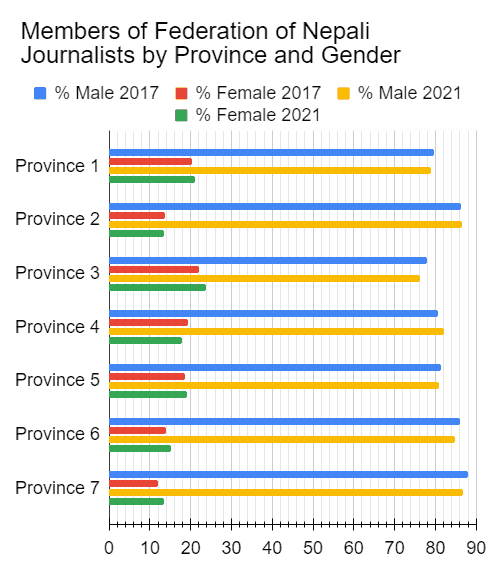
But of course, this is NOT an exceptional structure. This is a reflection of the society that Nepal is, one in which the social foundation that affect and determines all other structures and systems in the country is the caste system! You name it — from the three pillars of the democratic government, including the judiciary, to the bureaucracy to the army to the police to the entertainment industry to the education system to the banking system to…any structure of import you want to name. I don’t know if there’s any system in the country that’s NOT been corrupted directly or indirectly by the structure and hierarchy of the caste system.
You want a #challenge?
— Dorje Gurung, ScD (h.c.) (@Dorje_sDooing) February 23, 2021
I know you didn’t ask for it
but here it is anyway! 😁😁
Identify JUST ONE body
or system or industry from the list
below which in #Nepal is NOT#corrupt pretty much to the #core. pic.twitter.com/Xf4zD5K6sp
Apart from deliberate gatekeeping by the Khas-aryas, another reason behind these warped structures with disproportionately high representation of Khas-aryas and their control of the most important systems in the country continuing to persist is the high level of religiosity combined with a very low level of low quality education, and thus the society being closed and inward-looking. The level of religiosity is so high that most believe in — and explain — one’s birth caste by invoking the concept of karma — a result of one’s actions in past lives and therefore deserving of one’s context and circumstances of birth.
Nepali culture and society supports and props that belief up directly or indirectly, and individuals do so consciously or unconsciously. That is, Nepali society believes that Khas-aryas (the hill so-called high caste Hindus) are “deserving” of all the privileges or, in the Dalits’ case for example, disadvantages accompanying their birth caste. Hindu mythologies, which have shaped the moral and ethical beliefs and outlook on life of a vast majority of the population, affirm and reinforce the supremacy of the hill so-called high castes Hindu — the Khas-arya — men!
Of course, that the “disadvantges” were actually deliberately instituted by those who were born into “privilege” and “entitlement”, leading to their monopoly on positions of power and influence are not taught in academic institutions or talked or debated about, and conveniently swept under the rug. Like I said, I have yet to see Nepali media COLLECTIVELY doing a reckoning of itself in any way.
Worse, multiple times more of those men who occupy such position of power and influence are likely proud of themselves for their getting into such positions and being part of such structures than those who are embarrassed by it. I am embarrassed and that’s why I retweet tweets such the ones below accompanying them with satirical texts.
“Men men men men manly [Nepali] men men men”
— Dorje Gurung, ScD (h.c.) (@Dorje_sDooing) February 5, 2020
“Men men men men manly [Nepali] men men men”
(& one woman) #HallOfShame #Nepal #MenPal https://t.co/wH04txge1H
The above photo is of journalists with the then Prime Minister KP Oli after some official event. The one below is from the editor of The Kathmandu Post, one of the major English dailies in the country.
Men men men men manly men [friends of Sudheer Sharma at @kathmandupost ]
— Dorje Gurung, ScD (h.c.) (@Dorje_sDooing) March 7, 2020
Men men men men manly men [friends of @sudheerktm ]#HallOfShame #MenPal #MenPalsOfNepal #Nepal pic.twitter.com/UMZUdMSrBN
So, again, I suspect, CONSIDERABLY more men likely wear, as a badge of honor, that which is actually shameful. After all, to reiterate, our society makes those born a so-called “lower caste” ashamed of themselves, not those who deliberately profit from or take advantage of all those completely warped structures and systems!
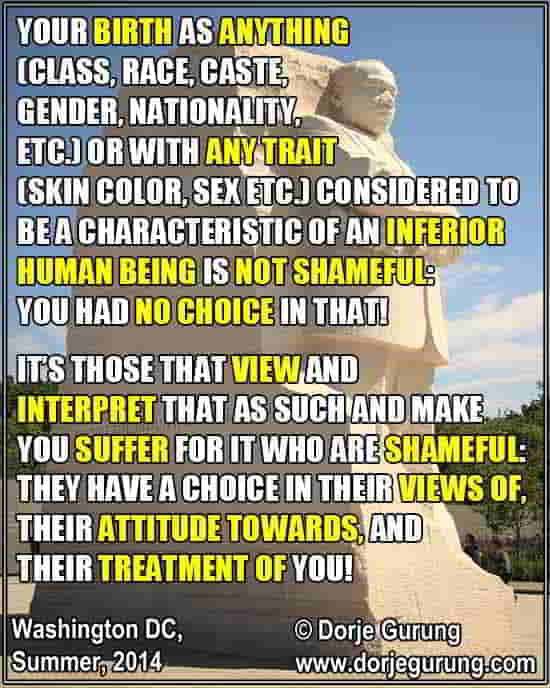
There are many more aspects of Nepali society that are actually shameful but about which the people are proud of. Some additional ones are arriving really late to public (official social) functions as the chief guest, rent-seeking mentality, corruption, Buddha being born in here etc. Shame is pride!
Of course, what needs to happen in this regard is something I voiced a while ago on twitter.
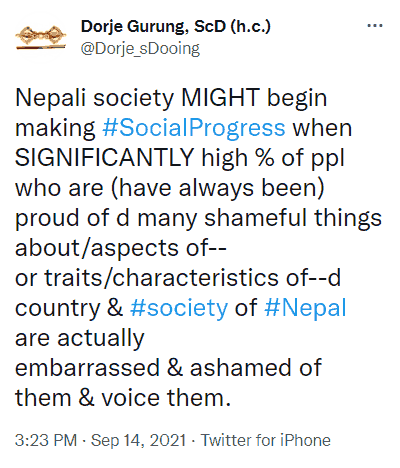
Will Nepali media start feeling that shame COLLECTIVELY about their composition and what they are furthering etc., if ever?
What do you think?
(If you are interested in blog posts about Nepali media and how they are found lacking, click here for blog post exposing the blatantly biased coverage by a number of Nepali publications of protests in Washington DC back in 2015. Click here for a blog post exposing the length Nepali media–except for two, a total of a dozen publications — spins a completely false story around an incident a Muslim official from the Southern Plains was involved in. The papers WRONGLY and, I have a feeling, DELIBERATELY blame the incident on a political party of the Southern Plains. As for the very arrogant and ignorant species that is we the unabashed Nepali men, I have here are the links to a series called Hall of Shame: I, II, III, IV, V and VI!)
References
Added after the publication of the blog because of their relevance.
The near complete lack of female representation means that the working environment for female journalists, for example, are very very toxic. The following are articles on the subject.
Shilapatra (Dec. 20, 2021). वरिष्ठ पत्रकारले जब छातीको साइज सोधे
PahiloPost (Sept. 18, 2021). ब्राको साइज सोध्ने पत्रकार [ब्लग]
The Kathmandu Post (Jan. 21, 2022). Women journalists say they face harassment, but actions rarely taken

